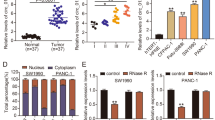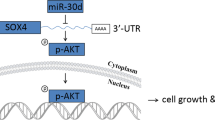Abstract
Pancreatic cancer (PC) is one of the most common and lethal cancers that affects millions of people around the world. The prognosis of PC is poor with very limited effective treatments. Here, we fully investigated the function and underlying mechanism of circSFMBT1 (hsa_circ_0066147) in PC. Real-time quantitative PCR, Western blotting, and immunohistochemistry were used to examine levels of circSFMBT1, miR-330-5p, PAK1 (p21-activated kinase 1), or proliferation/metastasis-related proteins. Colony formation assay, flow cytometry, and transwell assay detected the roles of circSFMBT1 and miR-330-5p in cell apoptosis, proliferation, migration, and invasion of PC cells, respectively. Dual luciferase assay and RNA immunoprecipitation were used to validate the interactions of circSFMBT1/miR-330-5p and miR-330-5p/PAK1. Fluorescence in situ hybridization was performed to examine the subcellular localization of circSFMBT1 and miR-330-5p. Subcutaneous tumor growth was monitored in nude mice and in vivo metastasis was examined as well following injection of PC cells into the tail vein. This study demonstrated that circSFMBT1 and PAK1 were up-regulated in PC tissues and cells, while miR-330-5p was down-regulated. circSFMBT1 directly bound miR-330-5p and inhibited its expression. In addition, circSFMBT1 promoted proliferation, migration, and invasion of PC cells through up-regulating proliferation-related proteins and down-regulating apoptosis-related proteins via miR-330-5p. miR-330-5p directly bound PAK1 mRNA and suppressed proliferation, migration, invasion, and epithelial–mesenchymal transition process via targeting PAK1 in PC cells. Further, knockdown circSFMBT1 increased miR-330-5p level, but decreased PAK1 expression and repressed tumor growth and metastasis in vivo. Taken together, circSFMBT1 promotes proliferation and metastasis of PC via regulating miR-330-5p/PAK1 pathway as a miR-330-5p sponge.
This is a preview of subscription content, access via your institution
Access options
Subscribe to this journal
Receive 12 print issues and online access
$259.00 per year
only $21.58 per issue
Buy this article
- Purchase on SpringerLink
- Instant access to full article PDF
Prices may be subject to local taxes which are calculated during checkout








Similar content being viewed by others
References
Rawla P, Sunkara T, Gaduputi V. Epidemiology of pancreatic cancer: global trends, etiology and risk factors. World J Oncol. 2019;10:10–27.
Orth M, Metzger P, Gerum S, Mayerle J, Schneider G, Belka C, et al. Pancreatic ductal adenocarcinoma: biological hallmarks, current status, and future perspectives of combined modality treatment approaches. Radiat Oncol. 2019;14:141.
Kamisawa T, Wood LD, Itoi T, Takaori K. Pancreatic cancer. Lancet. 2016;388:73–85.
Grasso C, Jansen G, Giovannetti E. Drug resistance in pancreatic cancer: impact of altered energy metabolism. Crit Rev Oncol Hematol. 2017;114:139–52.
Kristensen LS, Andersen MS, Stagsted LVW, Ebbesen KK, Hansen TB, Kjems J. The biogenesis, biology and characterization of circular RNAs. Nat Rev Genet. 2019;20:675–91.
Barrett SP, Salzman J. Circular RNAs: analysis, expression and potential functions. Development. 2016;143:1838–47.
Cocquerelle C, Mascrez B, Hetuin D, Bailleul B. Mis-splicing yields circular RNA molecules. FASEB J. 1993;7:155–60.
Guo JU, Agarwal V, Guo H, Bartel DP. Expanded identification and characterization of mammalian circular RNAs. Genome Biol. 2014;15:409.
Rong D, Sun H, Li Z, Liu S, Dong C, Fu K, et al. An emerging function of circRNA-miRNAs-mRNA axis in human diseases. Oncotarget. 2017;8:73271–81.
Meng S, Zhou H, Feng Z, Xu Z, Tang Y, Li P, et al. CircRNA: functions and properties of a novel potential biomarker for cancer. Mol Cancer. 2017;16:94.
Qu S, Hao X, Song W, Niu K, Yang X, Zhang X, et al. Circular RNA circRHOT1 is upregulated and promotes cell proliferation and invasion in pancreatic cancer. Epigenomics. 2019;11:53–63.
Mohr AM, Mott JL. Overview of microRNA biology. Semin Liver Dis. 2015;35:3–11.
Rupaimoole R, Slack FJ. MicroRNA therapeutics: towards a new era for the management of cancer and other diseases. Nat Rev Drug Discov. 2017;16:203–22.
Gong J, Chu Y, Xu M, Huo J, Lv L. Esophageal squamous cell carcinoma cell proliferation induced by exposure to low concentration of cigarette smoke extract is mediated via targeting miR-101-3p/COX-2 pathway. Oncol Rep. 2016;35:463–71.
Cao J, Liu J, Xu R, Zhu X, Liu L, Zhao X. MicroRNA-21 stimulates epithelial-to-mesenchymal transition and tumorigenesis in clear cell renal cells. Mol Med Rep. 2016;13:75–82.
Wang S, Zeng Y, Zhou JM, Nie SL, Peng Q, Gong J, et al. MicroRNA-1246 promotes growth and metastasis of colorectal cancer cells involving CCNG2 reduction. Mol Med Rep. 2016;13:273–80.
Song L, Xie X, Yu S, Peng F, Peng L. MicroRNA126 inhibits proliferation and metastasis by targeting pik3r2 in prostate cancer. Mol Med Rep. 2016;13:1204–10.
Weber MJ. New human and mouse microRNA genes found by homology search. FEBS J. 2005;272:59–73.
Mao Y, Chen H, Lin Y, Xu X, Hu Z, Zhu Y, et al. microRNA-330 inhibits cell motility by downregulating Sp1 in prostate cancer cells. Oncol Rep. 2013;30:327–33.
Li Y, Zhu X, Xu W, Wang D, Yan J. miR-330 regulates the proliferation of colorectal cancer cells by targeting Cdc42. Biochem Biophys Res Commun. 2013;431:560–5.
Lee KH, Chen YL, Yeh SD, Hsiao M, Lin JT, Goan YG, et al. MicroRNA-330 acts as tumor suppressor and induces apoptosis of prostate cancer cells through E2F1-mediated suppression of Akt phosphorylation. Oncogene. 2009;28:3360–70.
Feng L, Ma J, Ji H, Liu Y, Hu W. miR-330-5p suppresses glioblastoma cell proliferation and invasiveness through targeting ITGA5. Biosci Rep. 2017;37:BSR20170019.
Trehoux S, Lahdaoui F, Delpu Y, Renaud F, Leteurtre E, Torrisani J, et al. Micro-RNAs miR-29a and miR-330-5p function as tumor suppressors by targeting the MUC1 mucin in pancreatic cancer cells. Biochim Biophys Acta. 2015;1853:2392–403.
Rane CK, Minden A. P21 activated kinase signaling in cancer. Semin Cancer Biol. 2019;54:40–9.
Eswaran J, Li DQ, Shah A, Kumar R. Molecular pathways: targeting p21-activated kinase 1 signaling in cancer-opportunities, challenges, and limitations. Clin Cancer Res. 2012;18:3743–9.
Shrestha Y, Schafer EJ, Boehm JS, Thomas SR, He F, Du J, et al. PAK1 is a breast cancer oncogene that coordinately activates MAPK and MET signaling. Oncogene. 2012;31:3397–408.
Symeonidis N, Lambropoulou M, Pavlidis E, Anagnostopoulos C, Tsaroucha A, Kotini A, et al. PAK1 expression in pancreatic cancer: clinicopathological characteristics and prognostic significance. Clin Med Insights Oncol. 2019;13:1179554919831990.
Xie L, Mao M, Xiong K, Jiang B. Circular RNAs: a novel player in development and disease of the central nervous system. Front Cell Neurosci. 2017;11:354.
Yang F, Liu DY, Guo JT, Ge N, Zhu P, Liu X, et al. Circular RNA circ-LDLRAD3 as a biomarker in diagnosis of pancreatic cancer. World J Gastroenterol. 2017;23:8345–54.
An Y, Cai H, Zhang Y, Liu S, Duan Y, Sun D, et al. circZMYM2 competed endogenously with miR-335-5p to regulate JMJD2C in pancreatic cancer. Cell Physiol Biochem. 2018;51:2224–36.
Xiao S, Yang M, Yang H, Chang R, Fang F, Yang L. miR-330-5p targets SPRY2 to promote hepatocellular carcinoma progression via MAPK/ERK signaling. Oncogenesis. 2018;7:90.
Yoo HI, Kim BK, Yoon SK. MicroRNA-330-5p negatively regulates ITGA5 expression in human colorectal cancer. Oncol Rep. 2016;36:3023–9.
Moran Y, Agron M, Praher D, Technau U. The evolutionary origin of plant and animal microRNAs. Nat Ecol Evol. 2017;1:27.
Semenova G, Chernoff J. Targeting PAK1. Biochem Soc Trans. 2017;45:79–88.
Itakura A, Aslan JE, Kusanto BT, Phillips KG, Porter JE, Newton PK, et al. p21-Activated kinase (PAK) regulates cytoskeletal reorganization and directional migration in human neutrophils. PLoS ONE. 2013;8:e73063.
Wang Y, Wang S, Lei M, Boyett M, Tsui H, Liu W, et al. The p21-activated kinase 1 (Pak1) signalling pathway in cardiac disease: from mechanistic study to therapeutic exploration. Br J Pharm. 2018;175:1362–74.
Woo TG, Yoon MH, Hong SD, Choi J, Ha NC, Sun H, et al. Anti-cancer effect of novel PAK1 inhibitor via induction of PUMA-mediated cell death and p21-mediated cell cycle arrest. Oncotarget. 2017;8:23690–701.
Tao J, Oladimeji P, Rider L, Diakonova M. PAK1-Nck regulates cyclin D1 promoter activity in response to prolactin. Mol Endocrinol. 2011;25:1565–78.
Funding
This work was supported by the National Natural Science Foundation of China (Grant No. 81472738).
Author information
Authors and Affiliations
Contributions
Guarantor of integrity of the entire study: Z-LY, H-LY; study concepts: SX; study design: SX, Z-LY, H-LY; definition of intellectual content: SX; literature research: S-LL; clinical studies: K-JL; experimental studies: SX, S-LL, K-JL, S-GY; data acquisition: SX, S-LL; data analysis: K-JL, Z-LY; statistical analysis: S-GY, H-LY; manuscript preparation: SX; manuscript editing: SX, Z-LY, H-LY; manuscript review: Z-LY, H-LY.
Corresponding authors
Ethics declarations
Conflict of interest
The authors declare that they have no conflict of interest.
Ethics approval and consent to participate
The study was reviewed and approved by the Ethics Committee of Second Xiangya Hospital of Central South University. All patients were informed of the detailed information about the study and written agreement. All animal experiments and protocols were reviewed and approved by the Animal Care and Use Committee of Second Xiangya Hospital of Central South University.
Additional information
Publisher’s note Springer Nature remains neutral with regard to jurisdictional claims in published maps and institutional affiliations.
Rights and permissions
About this article
Cite this article
Xu, S., Lei, SL., Liu, KJ. et al. circSFMBT1 promotes pancreatic cancer growth and metastasis via targeting miR-330-5p/PAK1 axis. Cancer Gene Ther 28, 234–249 (2021). https://doi.org/10.1038/s41417-020-00215-2
Received:
Revised:
Accepted:
Published:
Issue Date:
DOI: https://doi.org/10.1038/s41417-020-00215-2



